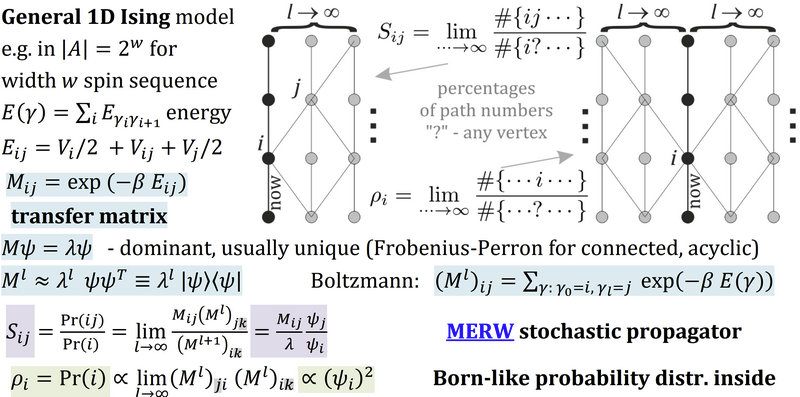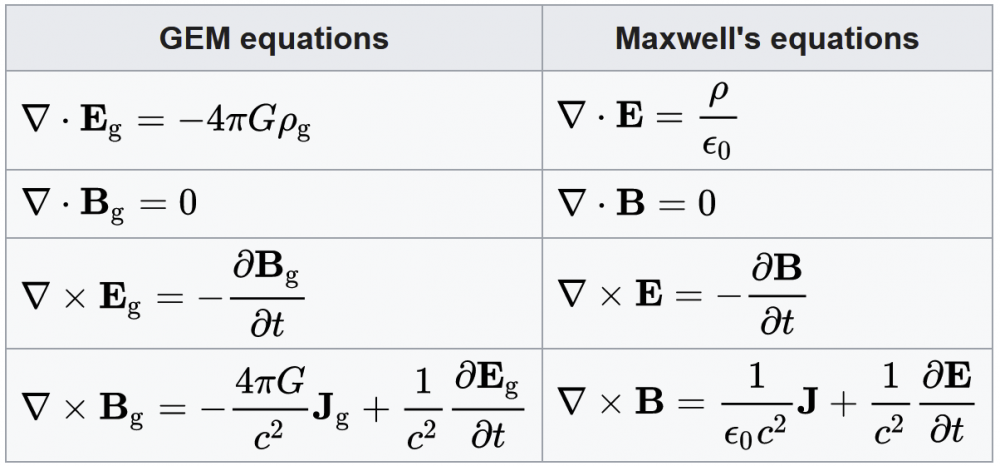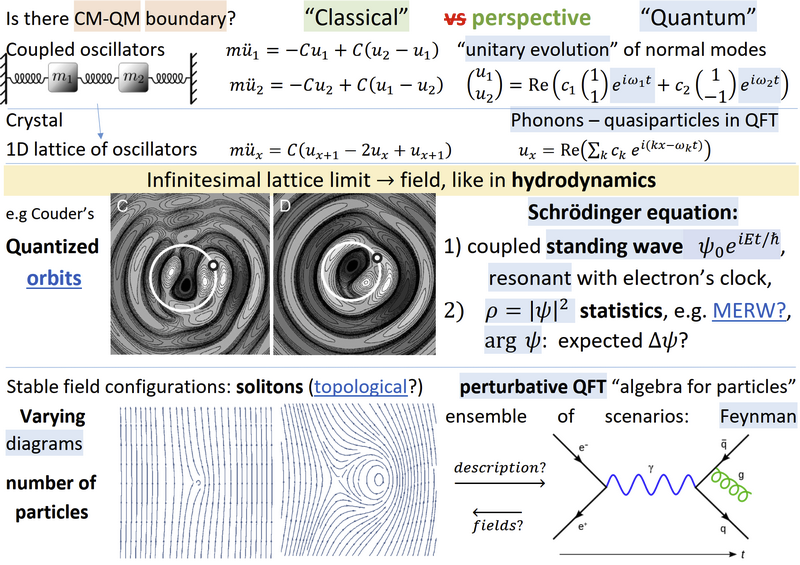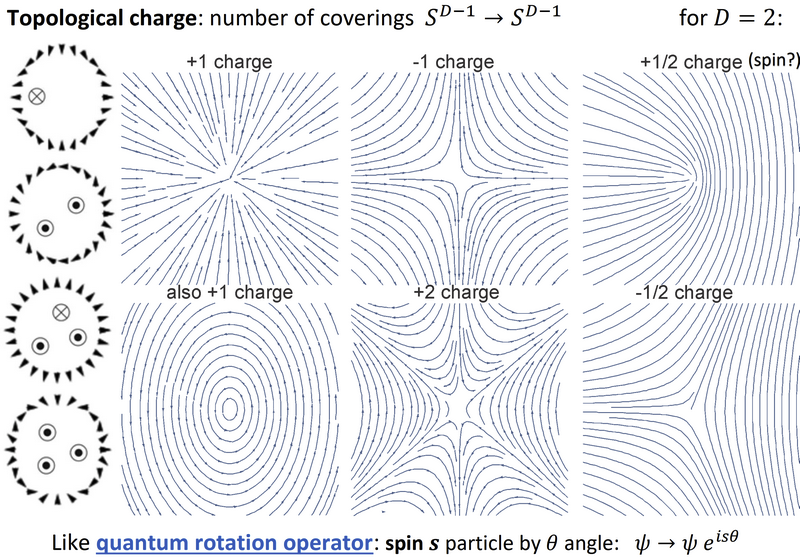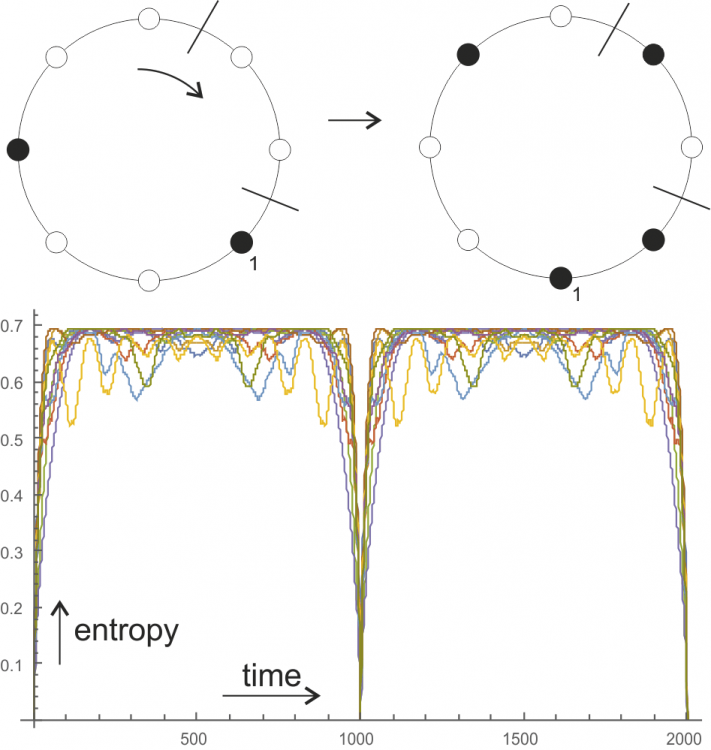

Duda Jarek
Senior Members-
Posts
572 -
Joined
-
Last visited
Content Type
Profiles
Forums
Events
Everything posted by Duda Jarek
-

Thought experiment: how would physics develop without Einstein?
Duda Jarek replied to Duda Jarek's topic in Physics
But which experiment would bring certainty that we need to give up flat spacetime? From https://en.wikipedia.org/wiki/Tests_of_general_relativity : - Perihelion precession of Mercury is GEM: "Gravitoelectric effects" + Lense–Thirring precession - Deflection of light by the Sun - would need some EM-GEM coupling: slowing down of EM propagation in presence of gravitational field, - gravitational time dilation - clocks are usually based on EM propagation e.g. in atoms, so slowing down of EM would slow down clocks ... the question is other interactions: what do we know about gravitational time dilation e.g. for muon decay? - Gravity Probe B tested GEM, - gravitational waves - also in GEM ... ... black holes - sure we have objects of extremely high density, but how to distinguish what is happening inside? -

Thought experiment: how would physics develop without Einstein?
Duda Jarek replied to Duda Jarek's topic in Physics
Indeed special relativity did not require Einstein, as it was already e.g. in EM/GEM Maxwell's equations. General relativity introduced intrinsic curvature of spacetime, while earlier it was thought to be flat. So which experiments bring certainty that spacetime is curved? Sure we need it e.g. to bend photon trajectories, but looking e.g. at glass of water reminds that there are also other ways to bend photon trajectories - like some slowing down of EM propagation in presence of strong gravitational field here (some EM-GEM coupling), what would also lead to some gravitational time dilation effects. -

Thought experiment: how would physics develop without Einstein?
Duda Jarek posted a topic in Physics
A valuable thought experiment from neighboring thread - how would physics develop if there would be no Einstein, especially regarding gravity? While modern physicists might say that without him there would be "weeping and the gnashing of teeth", his introduction of general relativity a century ago seems to be event of extremely low probability (?) - so what if it wouldn't happen? Or imagine some hypothetical other civilization e.g. SETI is looking for - would it automatically get to GR? If not, how their physics would develop? Beside Newton's gravity, there was also known GEM before ( https://en.wikipedia.org/wiki/Gravitoelectromagnetism ) - just take Maxwell's equations to gravity, making it Lorentz-invariant theory. "The best confirmation of GR": Gravity Probe B in fact has confirmed GEM as approximation of GR. Without Einstein we would probably develop further Heavisides' GEM - adding corrections to Lagrangian (like in "Standard Model approach"), starting with EM-GEM coupling to bend photon trajectories by Sun ... the big question is if gravitational time dilation could be explained by such slowing down? GEM has no renormalization problem, trivially unifies with the rest of physics as it is just another F_munu F^munu in Lagrangian - many approaches to solve this problem like string theory might never appear (?) Where the problems would start - which experiments leave no doubts that we have to use GR instead of GEM? Which cannot be repaired with added terms to GEM Lagrangian? -
It would be interesting to derive (and confirm) general relativity corrections to Jefimenko equations ... Many GR confirmations like Gravity Probe B are in fact of GEM - what confirmations of higher order terms are there? GEM was introduced by Oliver Heaviside in 1893 and is Lorentz invariant ... interesting thought experiment: how physics would look like without Einstein? I believe they would build on GEM - adding corrections to Lagrangian, starting with EM-GEM coupling to bend photon trajectories by Sun. GEM has no renormalization problem, trivially unifies with the rest of physics as it is just another F_munu F^munu in Lagrangian - many approaches to solve this problem like string theory might never appear (?) Where the problems would start?
-
Looks like GEM approximation of general relativity (confirmed e.g. by Gravity Probe B): https://en.wikipedia.org/wiki/Gravitoelectromagnetism You can use standard methodology/tools from electromagnetism for that, like avoiding PDEs with Green's function e.g. in static https://en.wikipedia.org/wiki/Biot–Savart_law or general https://en.wikipedia.org/wiki/Jefimenko's_equations ps. Kepler problem simulator using this approximation: https://demonstrations.wolfram.com/KeplerProblemWithClassicalSpinOrbitInteraction/
-

What does it mean that physics it time/CPT symmetric?
Duda Jarek replied to Duda Jarek's topic in Physics
Sure, it is also possible that there are teapots flying throughout the Universe ( https://en.wikipedia.org/wiki/Russell's_teapot ). While we cannot exclude unimaginable amount of stuff, a practical rule to get anywhere is Ockham's razor ( https://en.wikipedia.org/wiki/Occam's_razor ) : "entities should not be multiplied without necessity" - before going to "exciting explanations" (loved by the bibliometric evaluation system), really explore the the nonmagical ones first. -

What does it mean that physics it time/CPT symmetric?
Duda Jarek replied to Duda Jarek's topic in Physics
So you agree or disagree? Such hypothetical "increased probability in presence" can be alternatively written e.g. as positron + gammas + proton-> 2 protons electron + gammas + antiproton -> 2 antiprotons with some exchange in Feynman diagrams with this additional particle (e.g. electron, proton, neutron). Our knowledge about violation of baryon number conservation is practically zero - couldn't observe any, which reason might be trying to get proton decay in room temperature, while it is hypothesized for muuuuuch more extreme conditions like baryongenesis or Hawking radiation (so maybe also center of neutron star?) My point is only that CPT violation is not necessary to explain domination of matter - other ways are e.g.: - fixed baryon number of the Universe - in Big Crunch preceding our Big Bang, - statistical symmetry breaking - some positive feedback mechanism like above, making "the more of one type, the easier to get even more" - finally leading to domination of one type, which initially could be chosen at random, analogously to chirality of life. ps. Regarding claim that proton decay is impossible because we couldn't observe it in room temperature water - we could disprove nuclear fusion in the same way ... some processes just need much more extreme conditions, much more for baryon number violation than for fusion. -

What does it mean that physics it time/CPT symmetric?
Duda Jarek replied to Duda Jarek's topic in Physics
So assume there is possible proton decay, for simplicity we can write: proton -> positron + gammas In hypothetical baryogenesis there would be needed some opposite process, e.g. with leptons from pair creation: gammas -> electron + position. If possible, it would be still extremely unlikely, its nearly negligible probability (cross section) could be affected by local situation, like "catalyzed by presence of slow positive charge" (e.g. flying nearby, with photon exchange in Feynman diagram) improving a bit this probability - what would be sufficient for statistical symmetry breaking by two CPT symmetric rules: positron + gammas -> proton (with increased probability in presence of proton) electron + gammas -> antiproton (with increased probability in presence of antiproton) This kind of catalyzing property: increased fitness of L-aminoacid based life in presence of L-aminoacid based life, or increased probability of creation of proton in presence of proton, allows for symmetric set of rules leading to statistical symmetry breaking - nearly complete domination of one of them, initially chosen at random. -

Hijack from What does it mean that physics it time/CPT symmetric?
Duda Jarek replied to SergUpstart's topic in Speculations
Parallel universe explanation seems as coming from some Star Trek fans. Going back to earth, sounds a bit like CPT analogue of laser: with involved particles going in opposite direction, neutrinos here. -

What does it mean that physics it time/CPT symmetric?
Duda Jarek replied to Duda Jarek's topic in Physics
Baryogenesis hypothesis requires violation of baryon number conservation - like Hawking radiation or unobserved (at least in room temperature) https://en.wikipedia.org/wiki/Proton_decay : we can search for CPT symmetric rule which makes 1/2-1/2 ratio situation statistically repelling, like in presence of some matter (proton, electron) it is a bit more likely to create proton, and symmetrically in presence of antimatter it is a bit more likely to create antiproton. Otherwise: if baryon number is ultimately conserved, there remains e.g. Cyclic Universe hypothesis: that baryon number was the same in Big Crunch preceding our Big Bang - shifting this problem to minus infinity. Regarding biology, indeed alternative explanation is that creation of life is so improbable that it just happened only once around here - this way randomly choosing one of chiralities. Synthetic biology is currently running to synthesize mirror version of a cell, e.g. mirror polymerase was synthesized in 2016, but such mirror life might turn out extremely dangerous as not having natural enemies: https://en.wikipedia.org/wiki/Mirror_life -

What does it mean that physics it time/CPT symmetric?
Duda Jarek replied to Duda Jarek's topic in Physics
Regarding baryon asymmetry, I would say it is statistical symmetry breaking: that symmetric situation is statistically repelling. Like for e.g. L-amino acids in our life: while there is symmetry, the more one type of them, the easier development of life based on the same (more resources in environment) - making 1/2-1/2 ration statistically repelling, leading to nearly complete domination of one of them - originally chosen e.g. in a random way. For baryon asymmetry we don't need CPT violation, it is sufficient to have this kind of statistical repelling. For example that in baryogenesis: "creation of proton is a bit more likely in presence of electron" plus symmetric "creation of antiproton is a bit more likely in presence of positron" such two symmetric rules would make 1/2-1/2 ratio matter-antimatter state statistically repelling, leading to nearly complete domination of one of them, e.g. initially chosen in a random way. -

What does it mean that physics it time/CPT symmetric?
Duda Jarek replied to Duda Jarek's topic in Physics
For the scattering matrix as S_fi = <fin| S |in> it is good to see it as one amplitude being a result of propagator from -infinity time, second from +infinity, and S as propagator between them. This time-symmetric view is called TSVF: https://en.wikipedia.org/wiki/Two-state_vector_formalism This way we get Born rule from time-symmetry, what also works if asking for probability distribution inside sequence from Ising model: using spatial symmetry instead of temporal, Boltzmann path ensemble instead of Feynman: Sure there is - what Gravity Probe B has directly tested is gravitoelectromagnetism approximation of general relativity, which is second: gravitational set of Maxwell's equations (necessary to make Newton force Lorentz invariant): https://en.wikipedia.org/wiki/Gravitoelectromagnetism Frame dragging, Lense-Thirring effects are gravitational analogues of Lorentz force ( https://en.wikipedia.org/wiki/Lense–Thirring_precession ). Kepler problem with such correction simulator: https://demonstrations.wolfram.com/KeplerProblemWithClassicalSpinOrbitInteraction/ In hydrodynamics, Coriolis force corresponds to Lorentz force, see e.g. https://www.pnas.org/content/107/41/17515 -

What does it mean that physics it time/CPT symmetric?
Duda Jarek replied to Duda Jarek's topic in Physics
@joigus, time ordering is required for performing calculations, but just to understand time/CPT symmetry it is sufficient to imagine e.g. history of the Universes as the result of ensemble of all possible Feynman diagrams throughout this history ... for unification with general relativity it should include ensemble of shapes of spacetime, what leads to infinity which is too large for standard renormalization techniques. Regarding topology, I usually use the below diagram: Coupled pendula can be defined through "classical" evolution, but we can also go to normal modes where evolution becomes just rotations - "unitary/quantum". Then we have lattice of pendula e.g. as crystal, its normal modes are plane waves ... and in QFT are treated as real particles - phonons. The difficulty comes with the continuous limit, but there are many hydrodynamical QM-like phenomena (like Casimir, Aharonov-Bohm, interference, tunneling, orbit quantization) - slides with links: https://www.dropbox.com/s/kxvvhj0cnl1iqxr/Couder.pdf For varying number of particles we use QFT, but we should be able to also ask for e.g. EM configuration behind each Feynman diagram, e.g. with nearly singularity for charge. In this picture particles are localized field configurations: solitons, e.g. topological for spin/charge quantization, for their effective description we still need ensemble of scenario - perturbative QFT. Soliton particle models are slowly getting to mainstream e.g. https://journals.aps.org/prl/abstract/10.1103/PhysRevLett.121.232002 Many these models of particles e.g. Penrose twisters work in this soliton picture, or e.g. from superfluid/superconductor very topological picture e.g. from Volovik's "The Universe in Helium droplet" - if somebody is interested, in 90 minutes we have online talk about it: http://th.if.uj.edu.pl/~dudaj/QMFNoT -
I don't know what it has to do with time, but here is a great list: https://en.wikipedia.org/wiki/List_of_fractals_by_Hausdorff_dimension Its two most complex formulas come from my https://demonstrations.wolfram.com/TheBoundaryOfPeriodicIteratedFunctionSystems/
-

What does it mean that physics it time/CPT symmetric?
Duda Jarek replied to Duda Jarek's topic in Physics
Lorentz invariance says that intuition of "objective time direction", "current situation" (hyperspace of constant time) are wrong - they literally change with velocity of observer. So it says something about time, but at most time symmetry (as in the CPT theorem requiring it for QFT), but special/general relativity alone don't need to combine it with P, they don't see charge C. Topological charge is great to understand spin/charge quantization, e.g. defining EM field as curvature of some vector field, Gauss law counts winding number/topological charge which has to be integer (Gauss-Bonnet theorem) - we get electromagnetism with built-in charge quantization (Faber's model, slides with links: https://www.dropbox.com/s/aj6tu93n04rcgra/soliton.pdf ). While they are P, T symmetric, the C symmetry changes the situation: -

What does it mean that physics it time/CPT symmetric?
Duda Jarek replied to Duda Jarek's topic in Physics
Personally I don't think wormholes are realized in nature, but assuming general relativity is true, in theory it allows for non-orientable spacetime, so such possibility needs to be included in considerations. And it gives very valuable thought experiment - for better understanding of nature of time. Another question is if there are possible CPT analogues of any phenomena? For example of laser - which stimulated emission causes excitation of target later. Is CPT analogue of laser possible? If so, shouldn't its stimulated absorption cause deexcitation of (constantly excited like lamp) target earlier? For free electron laser building its CPT analogue seems quite straightforward ... -

What does it mean that physics it time/CPT symmetric?
Duda Jarek replied to Duda Jarek's topic in Physics
General relativity at least in theory allows to directly perform T symmetry by non-time-orientable spacetime. For example imagine wormhole which glues like in Klein bottle - traveling through it should apply T or P symmetry. -

What does it mean that physics it time/CPT symmetric?
Duda Jarek replied to Duda Jarek's topic in Physics
While P and T symmetries are rather global, in theory we can make C locally: changing just one charge ... but it would switch direction of all Coulomb forces for it, making it a bit different situation - it seems the safest to think of all 3 CPT as global (?) ps. slides with links, diagrams (e.g. Wheeler, delayed choice): https://www.dropbox.com/s/0zl18yttgnpc52w/causality.pdf -

What does it mean that physics it time/CPT symmetric?
Duda Jarek replied to Duda Jarek's topic in Physics
Renormalization is mathematical trick to ignore infinities, e.g. of infinite energy of electric field of point charge (which seem not to have experimental basis) - it indeed works locally. But what do you mean that CPT symmetry is only local? It consists of C symmetry which indeed can be seen local, but how to imagine P and T symmetry as local? Considering scattering e.g. of topological solitons, we also need ensemble of scenarios: Feynman diagrams, but I cannot imaging how P, T symmetry could be local? -

What does it mean that physics it time/CPT symmetric?
Duda Jarek replied to Duda Jarek's topic in Physics
There is no entropy in this fundamental level like QFT (it is zero). For entropy we need to get to effective picture, like replacing positions of particles with densities - what is kind of mean field approximation. Fundamental symmetries can be violated on the level of solution, like throwing a rock to symmetric lake surface. Assuming there is a (time/CPT symmetric) tendency for entropy growth, low entropic Big Bang should cause 2nd law of thermodynamics. We know that Big Bang had low entropy, need to understand why - a natural explanation is that because everything was localized(?) -

What does it mean that physics it time/CPT symmetric?
Duda Jarek replied to Duda Jarek's topic in Physics
CPT symmetry is not limited to single particle, cannot we transform any Feynman diagram this way? Couldn't we imagine decomposition of the History of the Universe into Feynman diagrams and applying CPT symmetry to all of them? Regrading entropy, this is effective picture - having some concrete configuration of particles, there is no entropy (it is zero) ... To get entropy we need to go to statistical picture by some smoothing, mean field approximation - in which there is entropy and it has a general tendency to grow ... and this tendency might be time symmetric (?) Related question: under hypothetical assumption that our Universe will finally collapse (true or not), what should be entropy of such Big Crunch? Entropy should depend on situation (densities, energies) in a given moment - isn't Big Bang and Big Crunch similar from entropy perspective? "Proofs" of entropy growth e.g. of Boltzmann H-theorem for time symmetric systems seem a nonsense (we could also prove entropy growth after time symmetry - contradiction) - they always use some uniformity assumption "stoßzahlansatz", kind of mean field approximation. It is nicely seen in this this trivial Kac ring model - just dots on ring rotating by one position per time unit, switching color if crossing marked position (diagram below). It is time symmetric, we can "prove" entropy growth using such assumption (percentage of white balls = percentage of white balls before marked position). However, we can also have cyclic evolution of entropy (all white balls after 2n steps are again all white balls): https://pdfs.semanticscholar.org/aa48/764e372033dcd45feb8f487a3d10e2420088.pdf -
Time/CPT symmetry is at heart of many models of physics, like unitary evolution in quantum mechanics, or Lagrangian formalism we use from classical mechanics, electromagnetism, up to general relativity and quantum field theories. In theory we should be able to decompose any scenario (history of the Universe?) into ensemble of Feynman diagrams, apply CPT symmetry to all of them, getting CPT analogue of entire scenario (?) There are many QM-based experiments which kind of use time symmetry (?), for example (slides with links) : Wheeler experiment, delayed choice quantum eraser (DCQE), “asking photons where they have been”, “photonic quantum routers”, Shor algorithm as more sophisticated DCQE. However, this symmetry is quite nonintuitive, very difficult to really accept – mainly due to irreversibly, thermodynamical counterarguments (are there other reasons?) Can e.g. this conflict with 2nd law of thermodynamics be resolved by just saying that symmetry of fundamental theories can be broken on the level of solution, like throwing a rock into symmetric lake surface? Are all processes reversible? (e.g. wavefunction collapse, measurement) So is our world time/CPT symmetric? What does it mean? Personally I interpret it that we live in 4D spacetime, (Einstein's) block universe/eternalism: only travel through some solution (history of the universe) already found in time/CPT symmetric way, like the least action principle or Feynman path/diagram ensemble - is it the proper way to understand this symmetry? Are there other ways to interpret it?
-
Over a million doses of Oxford/AstraZeneca coronavirus vaccine possible by September, says researcher https://www.reuters.com/article/us-health-coronavirus-oxford-vaccine-res/over-a-million-doses-of-oxford-astrazeneca-covid-19-vaccine-possible-by-september-researcher-idUSKCN24L1TW Also two more Phase III (to 6 + 1 approved) in https://www.nytimes.com/interactive/2020/science/coronavirus-vaccine-tracker.html
-
https://www.nejm.org/doi/full/10.1056/NEJMoa2022483 General optimism and preparation for vaccine this December:
-
There was added "approved" on this vaccine tracker ... for military use, also in phase II:

